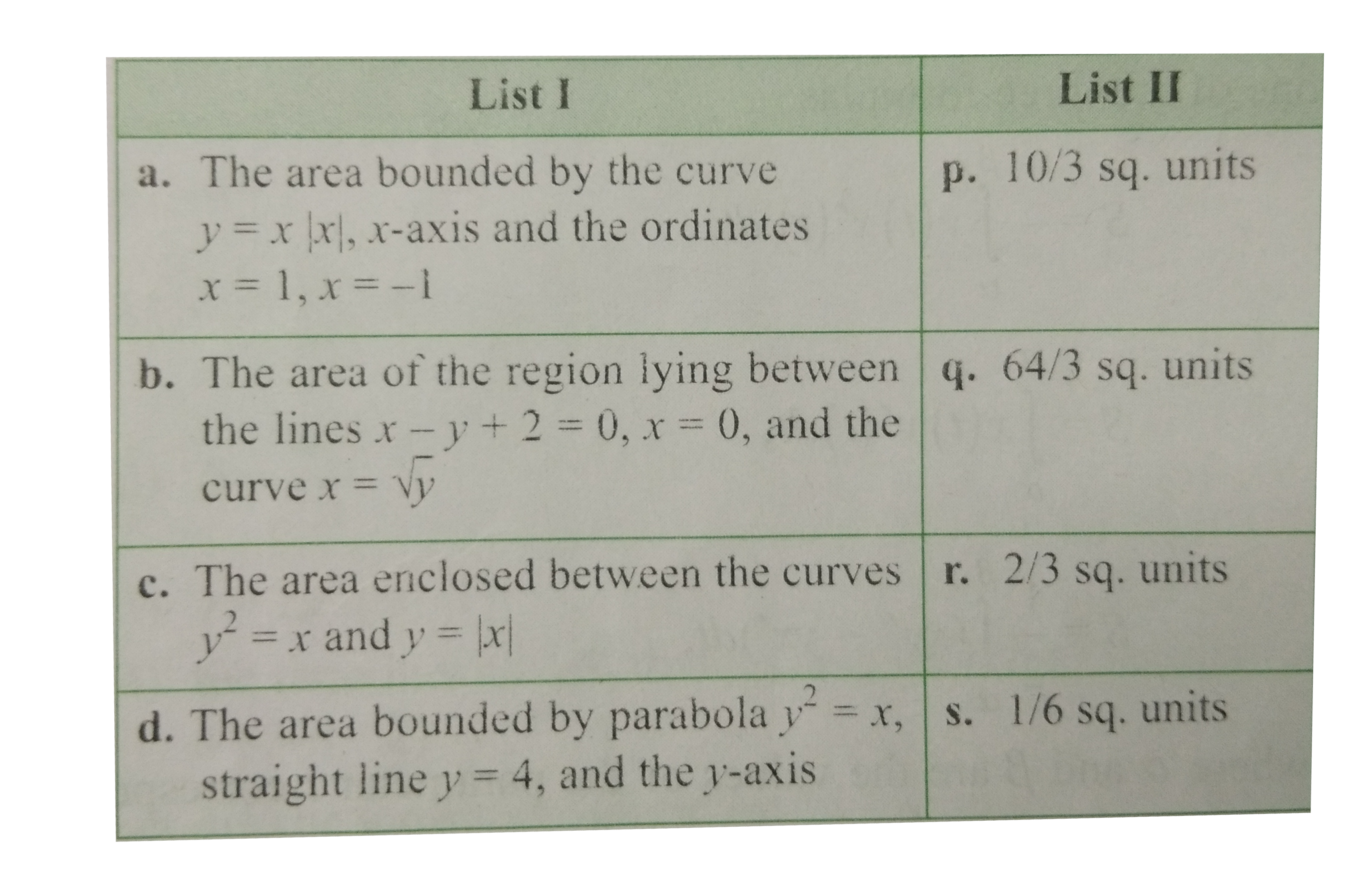Let Ar be the area of the region bounded between the curves y2=(e−kr)x(where k>0,r∈N) and the line y=mx(where m≠0), k and m are some constants
limn→∞Σni=1Ai=148(e2k−1) then the value of m isSolution in Tamil
3
1
2
4
The correct Answer is:C
Solving the two equations, we get
m2x2=(e−kr)x
x1=0,x2=e−krm2.

So, Ar=x2∫0(e−kr2√x−mx)dx
=23e−kr/2x3/22−mx222
=23e−kr/2e−3kr/2m3−m2e−2krm4=e−2kr6m3.
Now, Ar+1Ar=e−2k(r+1)e−2kr=e−2k=constant.
So, the sequence A1,A2,A3,... is in G.P.
Sum of n terms =e−2k6m3e−2nk−1e−2k−1=16m3e−2nk−11−e2k
Sum to infinte terms =A111−e−2k
=e−2k6m3×e2ke2k−1=16m3(e2k−1).
Topper's Solved these Questions
- BOOK - CENGAGECHAPTER - AREAEXERCISE - Exercise (Matrix)4videos
AREA
- BOOK - CENGAGECHAPTER - AREAEXERCISE - Exercise (Numerical)16videos
AREA
- BOOK - CENGAGECHAPTER - AREAEXERCISE - Exercise (Multiple)10videos
AREA
- BOOK - CENGAGECHAPTER - APPLICATIONS OF DERIVATIVESEXERCISE - Subjective Type2videos
APPLICATIONS OF DERIVATIVES
- BOOK - CENGAGECHAPTER - AREA UNDER CURVESEXERCISE - Question Bank10videos
AREA UNDER CURVES
Similar Questions
Match the following lists :
 06:02View Solution
06:02View SolutionThe area enclosed by the curve C:y=x√9−x2(x≥0) and the x-axis is___.
01:36View SolutionLet A(k) be the area bounded by the curves y=x2−3 and y=kx+2 The range of A(k) is (10√53,∞) The range of A(k) is (20√53,∞) If function k→A(k) is defined for k∈[−2,∞ ), then A(k) is many-one function. The value of k for which area is minimum is 1.
05:15View SolutionProve that for λ>1, the equation xlogx+x=λ has least one solution in [1,λ].
04:11View SolutionThe area of the region (s) enclosed by the curves y=x2 and y=√|x| is
03:26View SolutionIf a=(e^(2 pi i))/(7) and f(x)=A_(0)+sum_(k=1)^(20)A_(k)x^(k) then the value of sum_(r=0)^(6)f(a^(r)x)=n(A_(0)+A_(n)x^(n)+A_(2n)x^(2n)), then the value of n is
10:02View SolutionLet (1+x+x^(2))^(n)=sum_(r=0)^(2n)a_(r)*x^(r), where n is a positive integer,if we have a_(0)+a_(1)+a_(2)+.........+a_(n-1)=(3^(n)-a_(n))(2k) ,then the value of k isn 2n
10:13View SolutionLet be a sequence such that lim_(x rarr oo)a_(n)=0. Then lim_(n rarr oo)(a_(1)+a_(2)++a_(n))/(sqrt(sum_(k=1)^(n)k)), is
02:17View SolutionIf f(x)=sum_(k=0)^(n)a_(k)|x-1|^(k), where a_(i)in R, then
View SolutionLet alpha=(cos(2 pi))/(n)+i(sin(2 pi))/(n),n in N and let A_(k)=x+y alpha^(k)+z alpha^(2k)+...+w alpha^((n-1)k) where (k=0,1,2,...n-1) where x,y,z,...,u,w are n arbitrary complex numbers.Prove that sum_(k=0)^(n-1)|A_(k)|^(2)=n{|x|^(2)+|y|^(2)+|z|^(2)+...+|w|^(2)}
View SolutionLet Ar be the area of the region bounded between the curves y2=(e−kr)x(where k>0,r∈N) and the line y=mx(where m≠0), k and m are some constants
A1,A2,A3,… are in G.P. with common ratio10:48View SolutionLet Ar be the area of the region bounded between the curves y2=(e−kr)x(where k>0,r∈N) and the line y=mx(where m≠0), k and m are some constants
limn→∞Σni=1Ai=148(e2k−1) then the value of m is10:43View SolutionProve that am1+am2+….+amnn<(a1+a2+..+ann)m If 0<m<1andai>0 for all I.
13:48View SolutionConsider a parabola y=x24 and the point F(0,1). Let A1(x1,y1),A2(x2,y2),A3(x3,y3),.,An(xn,yn) are n points on the parabola such that xk>0 and ∠OFAk=kπ2n(k=1,2,……n) If the value of limx→∞(1n).n∑k=1FAk=mπ then m is .........
01:56View SolutionLet fnx+fn(y)=xn+ynxnyn∀x,y∈R−{0}. where n∈N and g(x)=max{f2(x),f3(x),12}∀x∈R−{0}
The number of value of ∞∑k=1f2k(cosecθ)+∞∑k=1f2k(secθ),wheretheta ne (kpi)/(2), k in I is:09:31View Solution

